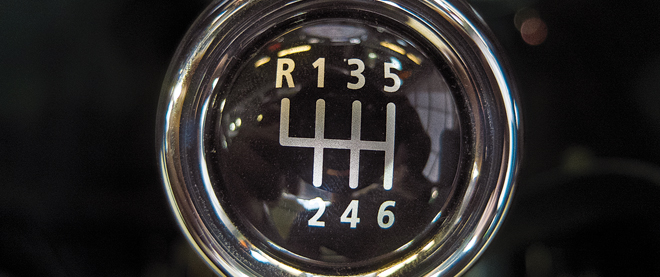Stick shifts make a comeback
Even though cars practically drive themselves, old-fashioned manual transmission is on the rise
Photograph by Andrew Tolson
Share

In a recent ad for the Cadillac CTS-V coupe, a well-groomed man wearing a suit speeds down a lonely road through the forest. As his hand reaches for the leather shift knob, a narrator asks: “Why did we build a 556-horsepower luxury car with a manual transmission? Because there are those who still believe in the power of a firm handshake.” Another recent ad, for the 2012 Chevrolet Sonic, also shows clips of the car being driven with a five-speed stick shift, amid images of young people listening to music and taking pictures of each other with their iPhones.
Meanwhile, Mazda and Mini are also talking about manuals in their ads, suggesting a resurgence in an aging automotive technology that, based on sales figures at least, appeared to be all but dead in North America. It’s estimated that only about 10 per cent of all vehicles on the road are equipped with manual transmissions, and that they account for as few as five per cent of new car purchases (although they remain popular in Europe). But dig a little further and it becomes apparent that the recent love affair with the stick shift may have more to do with marketing than changing motoring habits.
Michelle Krebs, a senior analyst at Edmunds.com, says there has long been an association in people’s minds between manual transmissions and performance. So while many CTS-V and Sonic drivers will end up buying cars with automatic transmissions for practical reasons—they are easier to drive in stop-and-go traffic while balancing a cellphone and Starbucks coffee—marketers know that they probably still like to think of themselves as Dale Earnhardt Jr. “Performance is about image,” she says.
The irony, of course, is that the effort comes at a time when most high-end performance carmakers like Porsche, Ferrari and Lamborghini are moving away from manuals in favour of dual-clutch “automated manual” transmissions that are capable of changing gears faster than any human could. Even Cadillac opted to use an automatic transmission car four years ago when a CTS-V completed a lap of Germany’s famous Nürburgring in a blistering seven minutes and 59 seconds, setting a record for a production sedan.
Hence, the trend seems to have more to do with a need to convince consumers that increasingly tech-laden vehicles, which do everything from mapping out routes to parallel parking, can still be fun to drive. Indeed, stick-shift fans have long argued that manuals offer a more “pure driving experience,” a true connection between man and machine. That includes Car and Driver editor Eddie Alterman, who launched a campaign two years ago to “Save the Manuals.” In a YouTube video, Alterman stands in a scrapyard and bemoans the decline of manual transmissions, which he argues are “fun, never accelerate unintentionally, and you can’t tweet, text or play Mafia Wars while driving one.” Manuals have also traditionally been cheaper and boast better gas mileage, although fuel economy ratings on some recent models now show little difference.
BMW recently launched a U.S. advertising campaign for its Mini brand that tells consumers to “Manual Up,” promising drivers “more control” and “more pure motoring exhilaration.” Robert Dexter, a spokesperson for BMW Canada, says the number of Mini buyers who opt for manual transmission on this side of the border is anywhere between 25 per cent and 65 per cent, depending on the model. He calls Mini drivers “eclectic” and “youthful” people who want to be involved in all aspects of driving their cars, which are sold with manual transmissions as standard equipment in Canada. Similarly, Mazda developed a new six-speed manual transmission for the 2012 Mazda 3, which will eventually be available on all the carmaker’s models. Mazda Canada spokesperson Sandra Lemaitre says that, while manual transmissions only account for about 15 per cent of Mazda sales in Canada, they play a key role in projecting the carmaker’s carefully honed “zoom-zoom” image.
The question is whether all of the advertising focus will actually cause consumers to rethink manual transmissions. Dexter, for one, isn’t holding his breath. He says that “in many cases now, automatics are now standard and manuals either optional or not available” in BMW’s lineup, and that there’s little reason for consumers to choose a manual over an automatic based on price, performance or fuel economy. And that’s coming from a car company that long boasted of its capacity to build the Ultimate Driving Machine.
Just don’t be surprised if the driver in the commercial is still shifting gears with a stick.